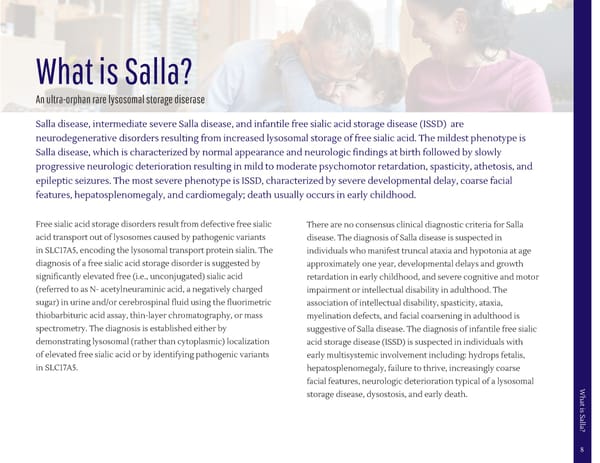What is Salla? An ultra-orphan rare lysosomal storage diserase Salla disease, intermediate severe Salla disease, and infantile free sialic acid storage disease (ISSD) are neurodegenerative disorders resulting from increased lysosomal storage of free sialic acid. The mildest phenotype is Salla disease, which is characterized by normal appearance and neurologic findings at birth followed by slowly progressive neurologic deterioration resulting in mild to moderate psychomotor retardation, spasticity, athetosis, and epileptic seizures. The most severe phenotype is ISSD, characterized by severe developmental delay, coarse facial features, hepatosplenomegaly, and cardiomegaly; death usually occurs in early childhood. Free sialic acid storage disorders result from defective free sialic There are no consensus clinical diagnostic criteria for Salla acid transport out of lysosomes caused by pathogenic variants disease. The diagnosis of Salla disease is suspected in in SLC17A5, encoding the lysosomal transport protein sialin. The individuals who manifest truncal ataxia and hypotonia at age diagnosis of a free sialic acid storage disorder is suggested by approximately one year, developmental delays and growth significantly elevated free (i.e., unconjugated) sialic acid retardation in early childhood, and severe cognitive and motor (referred to as N- acetylneuraminic acid, a negatively charged impairment or intellectual disability in adulthood. The sugar) in urine and/or cerebrospinal fluid using the fluorimetric association of intellectual disability, spasticity, ataxia, thiobarbituric acid assay, thin-layer chromatography, or mass myelination defects, and facial coarsening in adulthood is spectrometry. The diagnosis is established either by suggestive of Salla disease. The diagnosis of infantile free sialic demonstrating lysosomal (rather than cytoplasmic) localization acid storage disease (ISSD) is suspected in individuals with of elevated free sialic acid or by identifying pathogenic variants early multisystemic involvement including: hydrops fetalis, in SLC17A5. hepatosplenomegaly, failure to thrive, increasingly coarse facial features, neurologic deterioration typical of a lysosomal What is Salla? storage disease, dysostosis, and early death. 8
 2018-2019 progress report Page 8 Page 10
2018-2019 progress report Page 8 Page 10